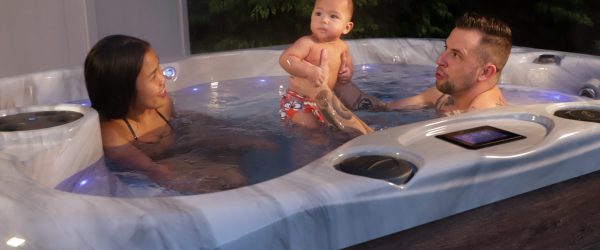Hot Tub Materials Decoded
-
Chad Dash Jenkins
- March 3, 2024
The Hot Tub Materials Showdown
Hot tubs are a significant investment in any home’s relaxation and entertainment space. I’m Chad Dash Jenkins, and I have been in the Hot Tub industry for over 6 years, and love to share my wealth of knowledge on the subject. What your hot tubs is made out of is super important. The material you choose for your hot tub not only affects its cost and durability but also its maintenance needs and aesthetic appeal. This guide delves into the five primary hot tub materials: Roto Mold, Acrylobond, Wood, Inflatable Plastics, and Fiberglass, providing you with the necessary information to make an informed decision. Whether you’re a hot tub hobbyist or a first-time buyer, get ready for a whirlpool of information that’s as relaxing as a soak in your very own spa.
Roto Mold Hot Tubs - What is Roto Mold?
Let’s start with a hot tub material know as Roto-Mold. Roto-Mold is a manufacturing process that creates virtually indestructible hot tubs. These hot tubs are known for their affordability and lightweight design, making them easy to install and relocate. However, they may not offer the same level of insulation as more expensive options, potentially leading to higher heating costs. Roto Mold hot tub material is reliable, durable, lightweight, and affordable. Roto-mold hot tubs are an excellent choice for those looking to relax without draining your bank account. Roto-Mold’s insulation might not hold the heat as long as some of its pricier pals, but this is still a great option for an entry level Hot Tub. I have known Roto-mold Hot tubs to last for 5+ years, with regular maintenance and some TLC.

Acrylobond Hot Tubs
Next up, Acrylobond enters the scene with a bit of flair. Think of Acrylobond as the sophisticated cousin in the hot tub family. It boasts a glossy finish that commands attention and offers a sturdy build that’s meant to last. When it comes to cleaning Acrylobond, Never – I repeat: Never use harsh cleaning chemicals on Acrylobond or any hot tub material. White vinegar and water in a 50/50 solutions will do the job. I always recommend to clean shell and outer surfaces right before you drain the water. The allure of Acrylobond is undeniable, but it does come with a reminder: sophistication can require a bit of upkeep.
Wooden Hot Tubs - The Classic Charm of Wood
Ah, Wood – the classic, timeless beauty. Wooden hot tubs bring that rustic charm and touch that makes you feel like you’re soaking in a piece of history. The warmth and natural aesthetic are unbeatable, but wood is a material that demands respect and regular maintenance to keep its classic beauty shining through the years. Hot tubs offer a natural and traditional aesthetic that many find appealing. They can be made from various types of wood, providing different colors and textures. Wood requires regular maintenance to prevent water damage and decay but can last many years with proper care.


Inflatable Plastic Hot Tubs - The Rise of Inflatable Hot Tubs
Inflatable Plastic hot tubs are the life of the party – easy to set up, even easier to enjoy. They’re the perfect plus-one for those with a nomadic heart or a tight budget. The jets are not going to blow you away, but you can still enjoy a warm dip. Most inflatable have a hard time maintaining the temp. and the jets are more like an underwater bubble blowing machine. While they bring the fun, they might not bring the longevity or the robust features of their harder-shelled relatives. But hey, who says you can’t have a blast in the meantime?
Fiberglass Hot Tubs - Stepping into Fiberglass
Fiberglass is sleek, modern and known for its smooth finish and customizable shapes. It’s like the hot tub world’s version of a tailored suit: it fits just right and looks really sharp. Fiberglass is strong, yet lightweight, and its maintenance is as smooth as its surface. But, with this type of opulence comes at a price, making it the more premium option. Fiberglass hot tubs can be more expensive upfront but are cost-effective over time due to their longevity and low maintenance needs. If your looking for a Hot tub that will last you for many years to come, then Fibreglass is the perfect option. What’s under the hood (pumps, heater, plumbing, filtration, filters etc.) is also important and I will speak more on this topic in a future article.
Comparison and Contrasts
By now, you might be wondering how to choose among these fantastic options. Well, think of it as choosing between different types of vacations – each has its unique flavor and perks, tailored to what kind of relaxation you’re seeking. Choose the one that will accommodate you and your family the best.
Installation and Maintenance
Configuring your hot tub paradise is an adventure in itself. From the easy-going inflatable to the steadfast fiberglass, each material offers its own journey from purchase to the first dip. And like any good relationship, a bit of TLC goes a long way in keeping the waters warm and welcoming. Remember weekly maintenance is the key to keeping your hot tub safe, clean, and easy to maintain. just 20 minutes or so a week, will keep your hot tub oasis look clear and inviting.
Environmental Considerations
In today’s world, thinking green is more important than ever. Luckily, eco-friendly options abound, from sustainably sourced wood to energy-efficient designs that keep both the planet and your wallet happy.Wood can be a sustainable choice if sourced responsibly, while high-quality insulation in Roto Mold and Fiberglass hot tubs can reduce energy consumption.
Cost Analysis
Let’s talk numbers, because everyone loves a good deal. Whether you’re looking for luxury or simplicity, understanding the cost versus the benefits of each material can help guide your decision to the perfect hot tub experience. Inflatable plastics offer the lowest initial cost, while Acrylobond and Fiberglass tend to be more of an investment. Consider not only the purchase price but also the long-term costs associated with energy use and maintenance.
Personalizing Your Hot Tub Experience
Customization is key to making your hot tub truly yours. From LED lights to jet configurations, each material offers unique ways to tailor your soak to suit your style. Always remember that customization options vary by material, with Fiberglass and Acrylobond offering the most flexibility in terms of design and features. Consider what custom features are important to you when making your selection.

The Verdict: Choosing the Right Material
Customization options can vary by material, with Fiberglass and Acrylobond offering the most flexibility in design and features. Make sure you consider what custom features are important to you when selecting. The best hot tub materials for you depend on your budget, maintenance capacity, aesthetic preference, and installation requirements. Each material has unique benefits and drawbacks, and the right choice will align with your needs and lifestyle.
Choosing the right hot tub materials is essential to ensure you enjoy your investment for years to come. Whether you prioritize durability, ease of maintenance, cost, or aesthetics, there is a hot tub material that meets your needs. Consider the points discussed in this guide to make an informed decision that enhances your home and lifestyle. If you have any questions or comments, please feel free to leave them below. I respect and appreciate your comments and feedback. Till next time, Happy Hot Tubbing.






